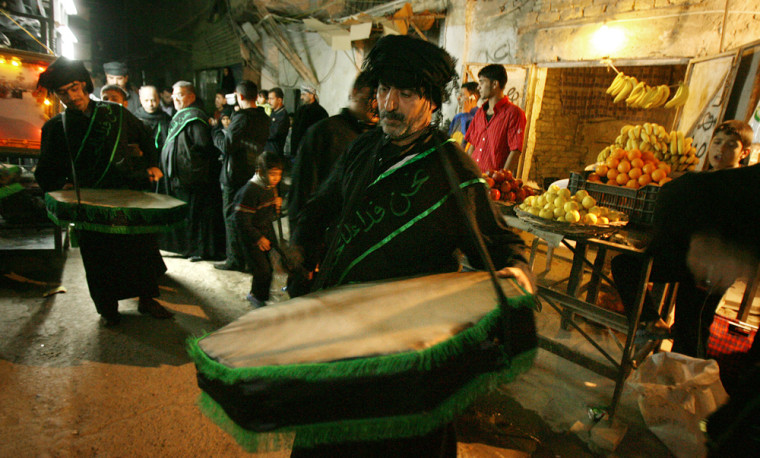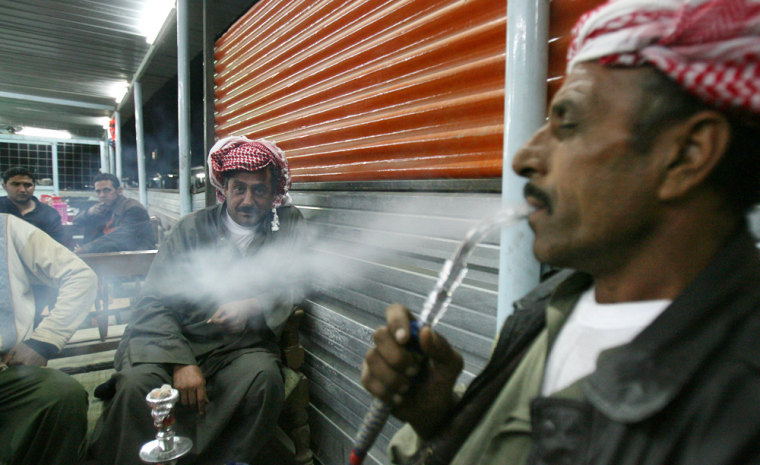Strings of bulbs festooning the Imam Kazim shrine’s four majestic minarets light up the sky over Baghdad’s Shiite Kazimiyah neighborhood, attracting thousands of nighttime worshippers.
Coffee houses and restaurants are packed with customers along nearby streets, where turbaned clerics, chador-clad women and families buy furniture, toys and clothes in teeming shops. The district’s gold market, the largest in the city, does brisk business until well after dusk.
But a drive from Kazimiyah over an unlit Tigris River bridge into Azamiyah, a Sunni stronghold, reveals only darkness and no signs of life along the main road. What nightlife does exist stays strictly within a walled area of about two square miles, heavily patrolled by Americans. One glaring exception: Kasrah, a Shiite enclave, with its lively outdoor market and coffee houses.
Night is the time when the Shiite dominance of the capital becomes most apparent following the sectarian “battle of Baghdad” that displaced tens of thousands of Sunnis and reshaped a city where the two sects had lived in relative peace.
As violence has eased over the past month or so, some neighborhoods, mostly Shiite, have regained much of their old confidence. Residents shop and eat out until as late as 9 p.m., more than four hours after sunset. Shiite neighborhoods enjoy the protection of both Shiite militiamen and the Shiite-dominated Iraqi security forces.
Karradah, a Shiite area in central Baghdad, has come closer to normalcy than any other Baghdad neighborhood. Thousands have been crowding its commercial heart after dark, shopping for the coming Muslim feast of Eid al-Adha in its colorfully lighted boutiques, dining on freshly cooked kebabs and falafel or buying fruits and vegetables from street stands.
Games played on bomb shelters
In some Shiite areas, nighttime can find teenagers playing soccer on the roof of a bomb shelter or Iraqi soldiers shooting pool next to a checkpoint. One evening in Kazimiyah last week, men from a local religious music band were on the street beating drums. Others were smoking water pipes, getting haircuts or shopping for electronics.
By contrast, many Sunni districts, particularly west of the Tigris, continue to look like war zones. Sunni areas saw a disproportionate amount of Baghdad’s fighting, most recently a U.S.-backed effort by residents to expel the most extremist of Sunni groups, al-Qaida in Iraq.

The Shiite-dominated government, complain some Sunnis, is always slower in devoting resources to their areas, and city workers have been afraid to enter Sunni neighborhoods to sweep the streets, collect trash or fix power cables and sewage pipes.
In Sunni areas where security has improved, residents now venture onto the streets during the day — traveling to work, shopping for food or visiting relatives. But signs of life mostly vanish by 6 p.m., with many people fearful of being kidnapped by a lurking Shiite militia or a resurgent al-Qaida in Iraq.
Members of the two Muslim sects once lived near each other in the same Baghdad neighborhoods. Nowadays, they live strictly in separate districts, carefully patrolled and ringed by tall, concrete barrier walls in some places. Shiite victories have shrunken Sunni areas, which often look deserted because many of its inhabitants fled Baghdad for exile in Syria or Jordan.
Travel between neighborhoods, a risky endeavor even during daylight hours, is rare after sunset — particularly when it involves a trip to or through a district inhabited by followers of the other sect.
Taxi driver Anmar Abdul-Hadi accepts rides only inside his neighborhood of Ghazaliyah, a former Sunni insurgent stronghold in western Baghdad. Even with that, the 30-year-old father of two makes a point of returning home by 8 p.m.
“I leave Ghazaliyah only in emergencies, and even then I don’t venture out too far,” he said.
Self-imposed curfew
Since the U.S.-led invasion in 2003, violence and crime have forced many Baghdad residents to hunker down at home beginning in the late afternoon. If they had electricity, many spent the long winter nights huddled around the TV or heaters. They spent their summer nights on rooftops to escape the city’s unforgiving heat.
Many are afraid of the dark. In a city once known throughout the Arab world for its busy night life, the setting of the sun now meant criminal gangs and death squads prowling for prey on dark streets, and jittery soldiers at checkpoints becoming nervous — and occasionally trigger happy.
“Night and darkness still fill us with fear,” said Mohammed Maguid, a 30-year-old civil servant from the mostly Shiite eastern Baghdad district of Baladiyat. “They make us think of the killings.”
It’s a time when people tend to pace or bite their nails. Breathing quickens. What passes for routine during the day becomes complicated and fraught with danger at night.
The sight of U.S. Army Strykers, for example, inspires awe even in daylight, but the giant eight-wheel fighting vehicles look a great deal more menacing in the twilight as they perilously speed past motorists eager to go home but stuck in traffic.
At a mass wedding party recently held at a Baghdad hotel, the host pleaded with guests to settle down quickly so the party gets under way and everyone can go home before dark.
“Settle down please, time is not on our side,” he told the 70 couples and their guests.
The call for the sunset prayers serves as the final warning that night has arrived.
Despite the resurgent nightlife in Shiite areas, reminders of the war are never far off — and the Imam Kazim shrine is no exception.
Prayers and war sounds
The recital of Quranic verses blaring from the shrine’s broadcast system mingled one recent evening with the rattle of gunfire and the scream of a warplane invisible in the night sky.

News of a deadly bombing in Karradah in the early evening of Dec. 5 traveled quickly to Kazimiyah, forcing some storekeepers to close earlier than usual and the streets to empty.
The bomb in a parked car along the busiest stretch of Karradah’s commercial heart killed 18 people and wounded 38.
It was not a particularly heavy death toll by Iraq’s grim standards, but enough to undermine the neighborhood’s soaring confidence.
“Karradah is sad,” said Karim Mohsen, who lost a friend in the blast. “I rushed to help him immediately after the blast, but one of his legs was missing. I looked for it, but could not find it. He died before I could see him in the hospital the next day.”
Soon after the bombing, storekeepers swept broken glass and debris in the darkness. Elsewhere in the neighborhood, people looked subdued. Many sat and drank coffee, watching others shop for groceries or walk briskly home along side streets.